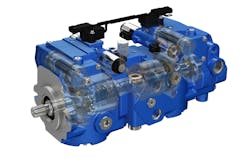The Benefits of Back-to-Back Hydraulic Pumps
The trend toward smaller machines is ushering in a host of new benefits, but it’s also bringing challenges. Operators are trying to shrink the size of their machines to improve dynamics involving weight and efficiency, but in doing so, they should avoid sacrificing the power needed to get the job done.
In short, machine designers must find ways to fit the required components with the right power into tight spaces to satisfy demands for smaller, more powerful equipment. Here are a few considerations concerning hydraulic pumps that might help engineers strike the right balance.
Efficiency and Beyond
Many industries have been affected by the drive for smaller machinery, but it seems construction and agriculture are at the forefront. Skid loaders, windrowers and other equipment common in these industries have been getting smaller for years, driven primarily by a need for more efficiency. Whether that efficiency is needed to meet regulatory standards or simply to lower operational or overall costs, machine size is a factor designers must consider.
Of course, as efficiency demands increase, so have productivity demands. An efficient machine that makes the jobsite inefficient helps no one; the machinery must maintain power and maneuverability despite a smaller and smaller size.
Productive jobsites are not just about the cost of buying and operating a machine, however. A growing shortage of qualified machine operators is starting to force design changes as well. Operators need equipment that is easier to operate, allowing for shorter training cycles, which helps get new operators into the field quicker.
Productivity gains also flow from smoother, more precise machine operations—more effectively placing concrete or moving equipment from A to B without tearing up the ground. A smooth, stable machine is also easier to operate.
This circular challenge of efficiency feeding productivity and vice-versa culminates with the question of reliability. Operators look for efficiency of investment as well as fuel consumption and operation.
The Right Pump
Back-to-back pumps let operators improve machine efficiency. They come in more useful sizes and offer precision and efficiency. They can also improve precision and repeatability.
Hysteresis, for example, plagues many who rely on fluid power on industrial and mobile equipment. Hysteresis refers to an error based on past input, a variation caused by friction and drag in a control loop’s various interfaces. In hydraulics, these interfaces are in servo valves, control pistons, swash plates and rotating pumps, mechanical feedback links and swash feedback valves.
Measured as a percentage of error against the pump’s peak flow, hysteresis ranges from 4 to 11%, with 5% typical of today’s pumps. Though 5% hysteresis sounds small, it means a 100-cc pump commanded to half displacement could produce 50 or 55 cc, depending on the previously commanded position. That’s enough to change the output flow and require the operator to compensate by changing the input command to get the desired flow.
Though hysteresis has historically been seen as a mere nuisance that must be accepted, it is often costly in terms of lost production time, efficiency and reliability. It can greatly degrade a machine’s precision, making it more difficult to operate, particularly for less-skilled drivers. As these factors become more important for operators, many have adjusted their machine design requirements to improve their bottom line.
Today’s back-to-back pumps can help designers reduce hysteresis (and compatibility with programmable controllers that make it easy to manage every system function) by providing current to the solenoid valves that forces the controller to minimize the difference between the desired position and existing positions via a swash feedback sensor in the pump. This sensor can bypass the source of mechanical friction and let the controller dynamically adjust solenoid valve current based on working conditions. This reduces the pump’s hysteresis and makes other control options possible.
When paired with a cartridge motor, the pump and controls can also create a compact propel solution with better control accuracy. As a machine designer looks to solve customer concerns, using software to customize machines makes it easier to design and build intelligent, compact equipment.
Back-to-back pumps can be equipped with roller bearings rather than the standard journal bearings. Swash roller bearings further reduce hysteresis reduction and wear-and-tear on the machine. This cuts down on the need for maintenance, allowing for longer uninterrupted machine use and more productivity
Brent Schenk is global product manager for medium-duty, closed-circuit piston pumps at Eaton Corp.
